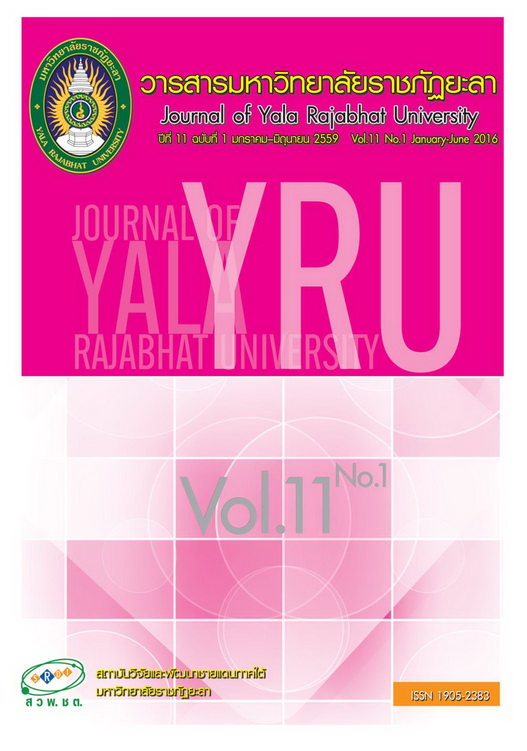อิทธิพลของพฤติกรรมระดับบุคคล กลุ่ม และองค์การ ต่อผลการปฏิบัติงานของข้าราชการตำรวจในจังหวัดชายแดนภาคใต้
Main Article Content
บทคัดย่อ
การศึกษาครั้งนี้มีวัตถุประสงค์เพื่อศึกษาอิทธิพลของพฤติกรรมระดับต่างๆ ที่มีต่อผลการปฏิบัติงานของข้าราชการตำรวจในจังหวัดชายแดนภาคใต้ เก็บข้อมูลกับกลุ่มตัวอย่างซึ่งเป็นข้าราชการตำรวจที่ปฏิบัติงานในสถานีตำรวจ 51 สถานี จำนวน 408 คน ทำการเก็บข้อมูล โดยใช้แบบสอบถามเพื่อวัดอิทธิพลของพฤติกรรมระดับต่างๆ ที่มีต่อผลการปฏิบัติงานของ ข้าราชการตำรวจ งานวิจัยนี ้มีตัวแปรที่ใช้ในการศึกษา 5 ตัว คือ ผลการปฏิบัติงาน ความยุติธรรมในองค์การ แรงจูงใจให้บริการสาธารณะ ความรักผูกพันในงาน และภาวะผู้นำการเปลี่ยนแปลง และมีค่าความเชื่อมั่นของแบบสอบถามอยู่ระหว่าง 0.65 – 0.96 ผลการศึกษาพบว่า แรงจูงใจให้บริการสาธารณะและความรักผูกพันในงาน ซึ่งเป็นพฤติกรรมระดับบุคคล มีอิทธิพลทางตรงต่อ ผลการปฏิบัติงานของข้าราชการตำรวจในจังหวัดชายแดนภาคใต้ โดยมีค่าสัมประสิทธิ์อิทธิพลเท่ากับ 0.67 และ 0.29 ตามลำดับ และภาวะผู้นำการเปลี่ยนแปลง ซึ่งเป็นพฤติกรรมระดับกลุ่ม มีอิทธิพลทางอ้อมต่อผลการปฏิบัติงานของข้าราชการตำรวจในจังหวัดชายแดนภาคใต้ ผ่านแรงจูงใจให้บริการสาธารณะ โดยมีค่าสัมประสิทธิ์อิทธิพลเท่ากับ 0.48 ที่ระดับนัยสำคัญ ทางสถิติ .01 โดยแรงจูงใจให้บริการสาธารณะนับเป็นปัจจัยที่มีอิทธิพลเด่นชัดที่สุด
Article Details
บทความ ข้อมูล เนื้อหา รูปภาพ ฯลฯ ที่ได้รับการเผยแพร่ในวารสารมหาวิทยาลัยราชภัฏยะลานี้ ถือเป็นลิขสิทธิ์ของวารสารมหาวิทยาลัยราชภัฏยะลา หากบุคคลหรือหน่วยงานใดต้องการนำทั้งหมดหรือส่วนหนึ่งส่วนใดไปเผยแพร่ต่อหรือกระทำการใดๆ จะต้องได้รับอนุญาตเป็นลายลักษณ์อักษรจากวารสารมหาวิทยาลัยราชภัฏยะลาก่อนเท่านั้น
เอกสารอ้างอิง
(หน้า 19-32). กรุงเทพฯ : สำนักงานเลขานุการคณะกรรมการพัฒนาระบบงานตำรวจ.
2.Bass, B. M. & Avolio, B. J. (1993). Transformational leadership: A response to critiques. In M. M. Chemers & R. Ayman (Eds.), Leadership theory and research:
Perspectives and directions (pp. 49-80). San Diego, CA: Academic Press.
3.Bollen, K. A. (1989). Structural equations with latent variables. New York: Wiley.
4.Christian, M. S., Garza, A. S. & Slaughter, J. E. (2011). Work engagement: A quantitative review and test of its relations with task and contextual performance. Personnel Psychology, 64(1), 89-136.
5.Greenberg, J. & Baron, R. A. (2003). Behavior in Organizations. (8th ed). Upper Saddle River, NJ: Pearson Education.
6.Hair, J. F., Black, W. C., Babin, B. J. & Anderson, R. E. (2010). Multivariate data analysis: A global perspective. (7th ed.). Upper Saddle River, NJ: Pearson Education.
7.Kim, S. (2006). Public service motivation and organizational citizenship behavior in Korea. International Journal of Manpower, 27(8), 722-740.
8.Kim, S. & Vandenabeele, W. (2010). A strategy for building public service motivation research internationally. Public Administration Review, 70(5), 701-709.
9.Motowidlo, S. J., Borman, W. C. & Schmit, M. J. (1997). A theory of individual differences in task and contextual performance. Human Performance, 10(2), 71-83.
10.Moynihan, D. P., Pandey, S. K. & Wright, B. E. (2009). Pulling the levers: Leadership, public service motivation and mission valence. Paper presented at the
International Public Service Motivation Research Conference, June 7-9, Bloomington, IN.
11.Rich, B. L., LePine, J. A. & Crawford, E. R. (2010). Job engagement: Antecedents and effects on job performance. Academy of Management Journal, 53(3), 617-635.
12.Robbins, S. P. & Judge, T. A. (2010). Organizational Behavior. (10th ed). Upper Saddle River, NJ: Prentice Hall.
13.Salanova, M., Agut, S. & Peiro, M. J. (2005). Linking organizational resources and work engagement to employee performance and customer loyalty: The mediation
of service climate. Journal of Applied Psychology, 90(6), 1217-1227.
14.Schumacker, R. E. & Lomax, R. G. (2010). A Beginner’s Guide to Structural Equation Modeling. (3rd ed). New York: Taylor & Francis.
15.Van Scotter, J. R. (2000). Relationships of task performance and contextual performance with turnover, job Satisfaction, and affective commitment. Human Resource Management Review, 10(1), 79-95.


